Alfa Romeo 156 2006 Owner handbook (in English)
Manufacturer: ALFA ROMEO, Model Year: 2006, Model line: 156, Model: Alfa Romeo 156 2006Pages: 357, PDF Size: 5.04 MB
Page 41 of 357
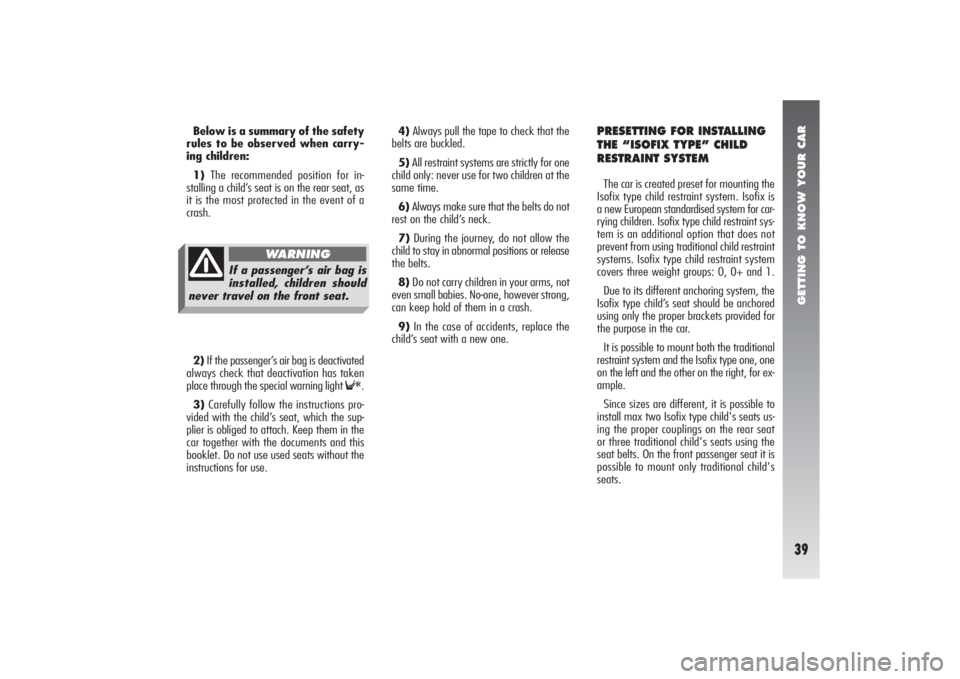
GETTING TO KNOW YOUR CAR39
4)Always pull the tape to check that the
belts are buckled.
5)All restraint systems are strictly for one
child only: never use for two children at the
same time.
6)Always make sure that the belts do not
rest on the child’s neck.
7)During the journey, do not allow the
child to stay in abnormal positions or release
the belts.
8)Do not carry children in your arms, not
even small babies. No-one, however strong,
can keep hold of them in a crash.
9)In the case of accidents, replace the
child’s seat with a new one.
PRESETTING FOR INSTALLING
THE “ISOFIX TYPE” CHILD
RESTRAINT SYSTEMThe car is created preset for mounting the
Isofix type child restraint system. Isofix is
a new European standardised system for car-
rying children. Isofix type child restraint sys-
tem is an additional option that does not
prevent from using traditional child restraint
systems. Isofix type child restraint system
covers three weight groups: 0, 0+ and 1.
Due to its different anchoring system, the
Isofix type child’s seat should be anchored
using only the proper brackets provided for
the purpose in the car.
It is possible to mount both the traditional
restraint system and the Isofix type one, one
on the left and the other on the right, for ex-
ample.
Since sizes are different, it is possible to
install max two Isofix type child's seats us-
ing the proper couplings on the rear seat
or three traditional child's seats using the
seat belts. On the front passenger seat it is
possible to mount only traditional child's
seats. Below is a summary of the safety
rules to be observed when carry-
ing children:
1)The recommended position for in-
stalling a child’s seat is on the rear seat, as
it is the most protected in the event of a
crash.
2)If the passenger’s air bag is deactivated
always check that deactivation has taken
place through the special warning light
F
.
3)Carefully follow the instructions pro-
vided with the child’s seat, which the sup-
plier is obliged to attach. Keep them in the
car together with the documents and this
booklet. Do not use used seats without the
instructions for use.
If a passenger’s air bag is
installed, children should
never travel on the front seat.
WARNING
Page 42 of 357
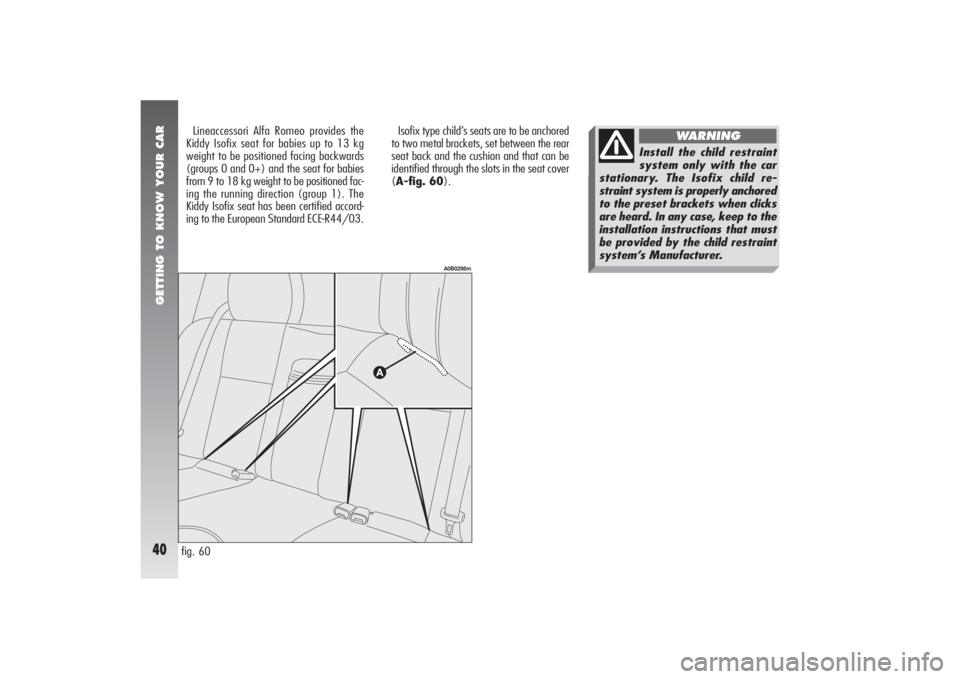
GETTING TO KNOW YOUR CAR40
fig. 60Isofix type child’s seats are to be anchored
to two metal brackets, set between the rear
seat back and the cushion and that can be
identified through the slots in the seat cover
(A-fig. 60). Lineaccessori Alfa Romeo provides the
Kiddy Isofix seat for babies up to 13 kg
weight to be positioned facing backwards
(groups 0 and 0+) and the seat for babies
from 9 to 18 kg weight to be positioned fac-
ing the running direction (group 1). The
Kiddy Isofix seat has been certified accord-
ing to the European Standard ECE-R44/03.
A0B0298m
Install the child restraint
system only with the car
stationary. The Isofix child re-
straint system is properly anchored
to the preset brackets when clicks
are heard. In any case, keep to the
installation instructions that must
be provided by the child restraint
system’s Manufacturer.
WARNING
Page 43 of 357
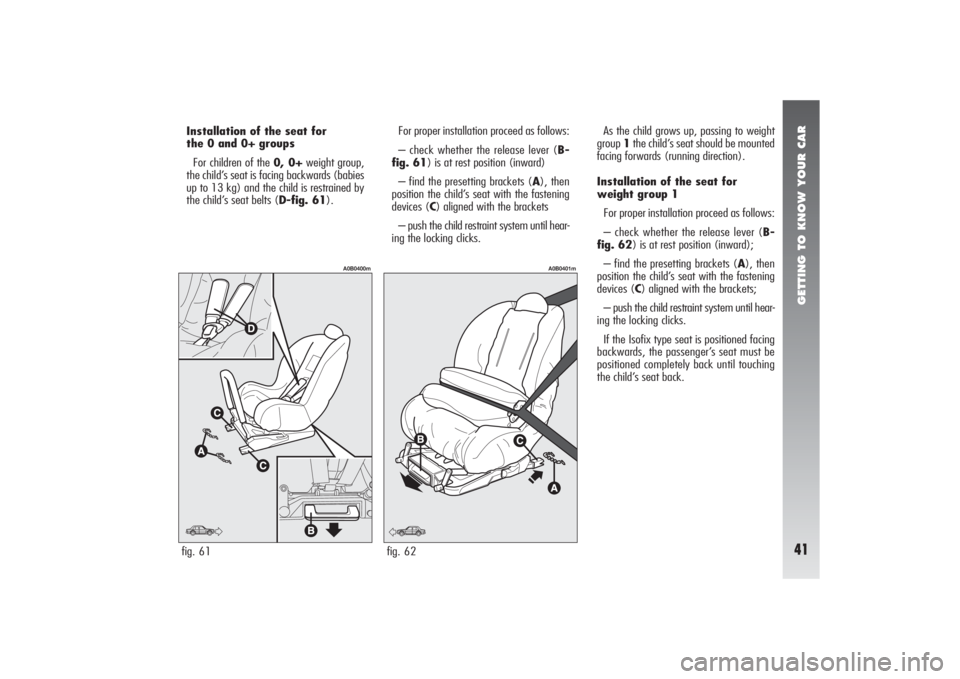
GETTING TO KNOW YOUR CAR41
For proper installation proceed as follows:
– check whether the release lever (B-
fig. 61) is at rest position (inward)
– find the presetting brackets (A), then
position the child’s seat with the fastening
devices (C) aligned with the brackets
– push the child restraint system until hear-
ing the locking clicks.As the child grows up, passing to weight
group 1the child’s seat should be mounted
facing forwards (running direction).
Installation of the seat for
weight group 1
For proper installation proceed as follows:
– check whether the release lever (B-
fig. 62) is at rest position (inward);
– find the presetting brackets (A), then
position the child’s seat with the fastening
devices (C) aligned with the brackets;
– push the child restraint system until hear-
ing the locking clicks.
If the Isofix type seat is positioned facing
backwards, the passenger’s seat must be
positioned completely back until touching
the child’s seat back. Installation of the seat for
the 0 and 0+ groups
For children of the 0, 0+weight group,
the child’s seat is facing backwards (babies
up to 13 kg) and the child is restrained by
the child’s seat belts (D-fig. 61).
fig. 61
A0B0400m
fig. 62
A0B0401m
Page 44 of 357
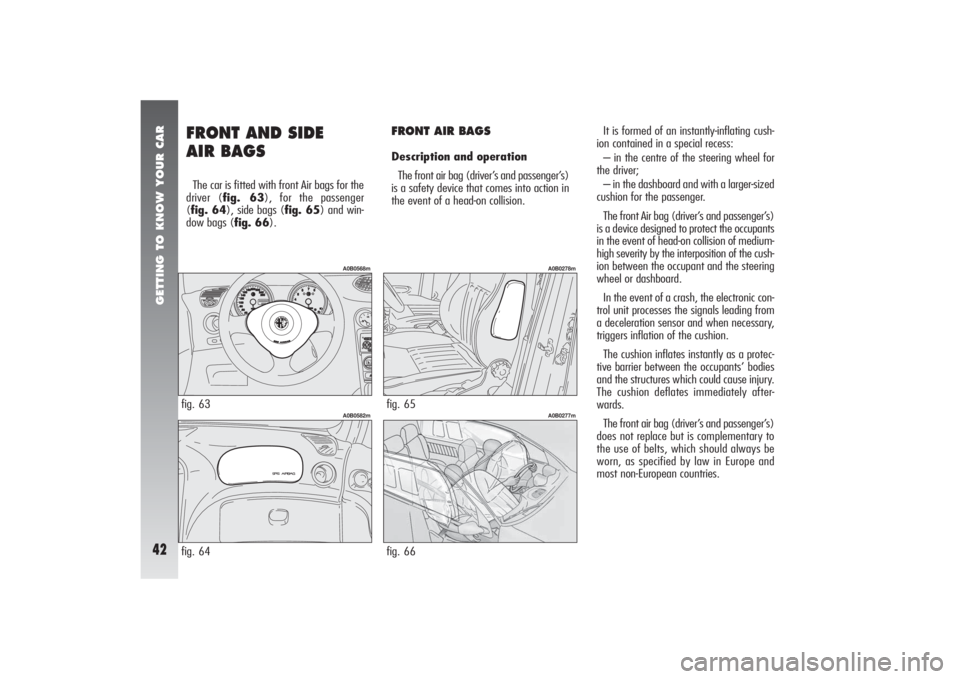
GETTING TO KNOW YOUR CAR42
FRONT AND SIDE
AIR BAGS The car is fitted with front Air bags for the
driver (fig. 63), for the passenger
(fig. 64), side bags (fig. 65) and win-
dow bags (fig. 66).
FRONT AIR BAGSDescription and operation
The front air bag (driver’s and passenger’s)
is a safety device that comes into action in
the event of a head-on collision.It is formed of an instantly-inflating cush-
ion contained in a special recess:
– in the centre of the steering wheel for
the driver;
– in the dashboard and with a larger-sized
cushion for the passenger.
The front Air bag (driver’s and passenger’s)
is a device designed to protect the occupants
in the event of head-on collision of medium-
high severity by the interposition of the cush-
ion between the occupant and the steering
wheel or dashboard.
In the event of a crash, the electronic con-
trol unit processes the signals leading from
a deceleration sensor and when necessary,
triggers inflation of the cushion.
The cushion inflates instantly as a protec-
tive barrier between the occupants’ bodies
and the structures which could cause injury.
The cushion deflates immediately after-
wards.
The front air bag (driver’s and passenger’s)
does not replace but is complementary to
the use of belts, which should always be
worn, as specified by law in Europe and
most non-European countries.
fig. 63
A0B0568m
fig. 64
A0B0582m
fig. 65
A0B0278m
fig. 66
A0B0277m
Page 45 of 357

GETTING TO KNOW YOUR CAR43
In the event of a crash a person that is not
wearing the seat belt moves forwards and
may come into contact with the cushion
while it is still opening. Under these cir-
cumstances the protection offered by the
cushion is reduced.
Front air bags are designed to protect car’s
occupants in front crashes and therefore non-
activation in other types of collisions (side
collisions, rear-end shunts, roll-overs, etc…)
is not a system malfunction.
In collisions against highly deformable or
mobile objects (road signposts, heaps of ice
or snow, etc.), rear collisions (hit from be-
hind by another vehicle), side collisions,
wedging under other vehicles or protective
barriers (for example under a lorry or guard
rail) cutting in of the air bag is not activated
as it does not offer any more protection than
the seat belts therefore activation would be
inappropriate.
Therefore the failure to be triggered does
not mean that the system is not working
properly.
PASSENGER’S FRONT
AIR BAGThe passenger’s front air bag has been de-
signed to improve the protection of a per-
son wearing a seat belt.
Its volume at maximum inflation fills most
of the space between the dashboard and the
passenger.
SERIOUS DANGER:
The car is fitted
with front passenger’s air bag.
Never place cradle child’s seats on
the front passenger seat of cars
equipped with passenger air bag
since the air bag activation could
cause serious injuries, even mortal.
In the case of need, always deac-
tivate the passenger’s air bag
when a child’s seat is placed on the
front seat. The front passenger
seat shall be adjusted in the most
backward position to prevent any
contact between child’s seat and
dashboard. Even if not ruled by
law, for better protection of adults
you are recommended to reactivate
the air bag immediately as soon as
child transport is no longer neces-
sary.
WARNING
Please don’t apply stickers
or other objects to the
steering wheel, to the air-bag
cover on the passenger's side or on
the side roof lining to the uphol-
stery on the roof side. Don’t place
objects on the dashboard passen-
ger’s side (such as mobile phones)
because they could tamper with the
correct opening of the passenger’s
air-bag and than cause serious in-
juries to the vehicle occupants.
WARNING
Page 46 of 357
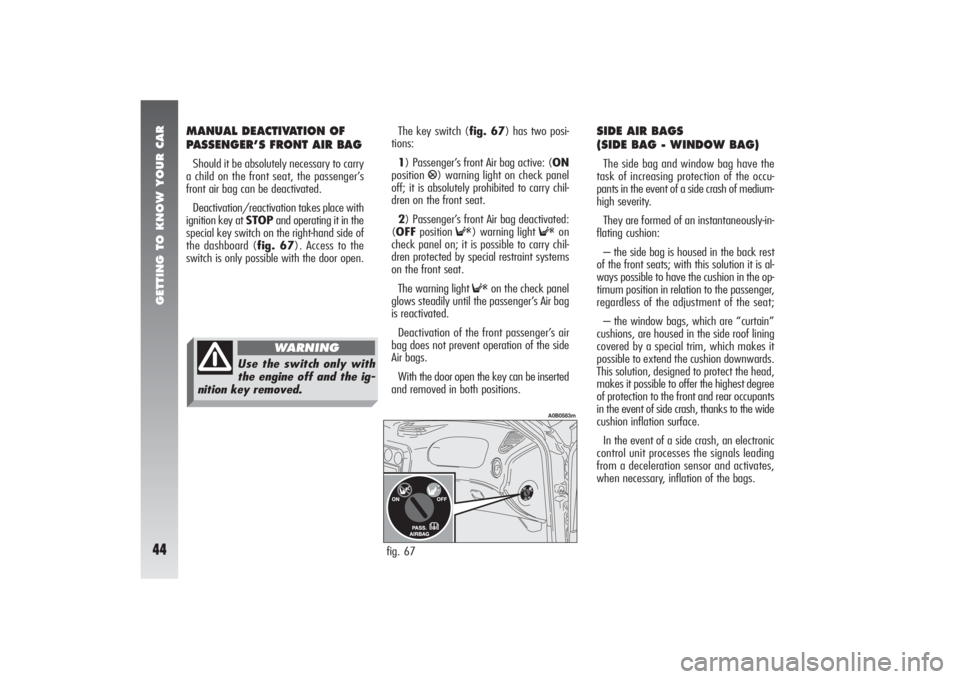
GETTING TO KNOW YOUR CAR44
MANUAL DEACTIVATION OF
PASSENGER’S FRONT AIR BAGShould it be absolutely necessary to carry
a child on the front seat, the passenger’s
front air bag can be deactivated.
Deactivation/reactivation takes place with
ignition key at STOPand operating it in the
special key switch on the right-hand side of
the dashboard (fig. 67). Access to the
switch is only possible with the door open.The key switch (fig. 67) has two posi-
tions:
1) Passenger’s front Air bag active: (ON
position
P) warning light on check panel
off; it is absolutely prohibited to carry chil-
dren on the front seat.
2) Passenger’s front Air bag deactivated:
(OFFposition
F
) warning light
F
on
check panel on; it is possible to carry chil-
dren protected by special restraint systems
on the front seat.
The warning light
F
on the check panel
glows steadily until the passenger’s Air bag
is reactivated.
Deactivation of the front passenger’s air
bag does not prevent operation of the side
Air bags.
With the door open the key can be inserted
and removed in both positions.
SIDE AIR BAGS
(SIDE BAG - WINDOW BAG)The side bag and window bag have the
task of increasing protection of the occu-
pants in the event of a side crash of medium-
high severity.
They are formed of an instantaneously-in-
flating cushion:
– the side bag is housed in the back rest
of the front seats; with this solution it is al-
ways possible to have the cushion in the op-
timum position in relation to the passenger,
regardless of the adjustment of the seat;
– the window bags, which are “curtain”
cushions, are housed in the side roof lining
covered by a special trim, which makes it
possible to extend the cushion downwards.
This solution, designed to protect the head,
makes it possible to offer the highest degree
of protection to the front and rear occupants
in the event of side crash, thanks to the wide
cushion inflation surface.
In the event of a side crash, an electronic
control unit processes the signals leading
from a deceleration sensor and activates,
when necessary, inflation of the bags.
fig. 67
A0B0583m
Use the switch only with
the engine off and the ig-
nition key removed.
WARNING
Page 47 of 357
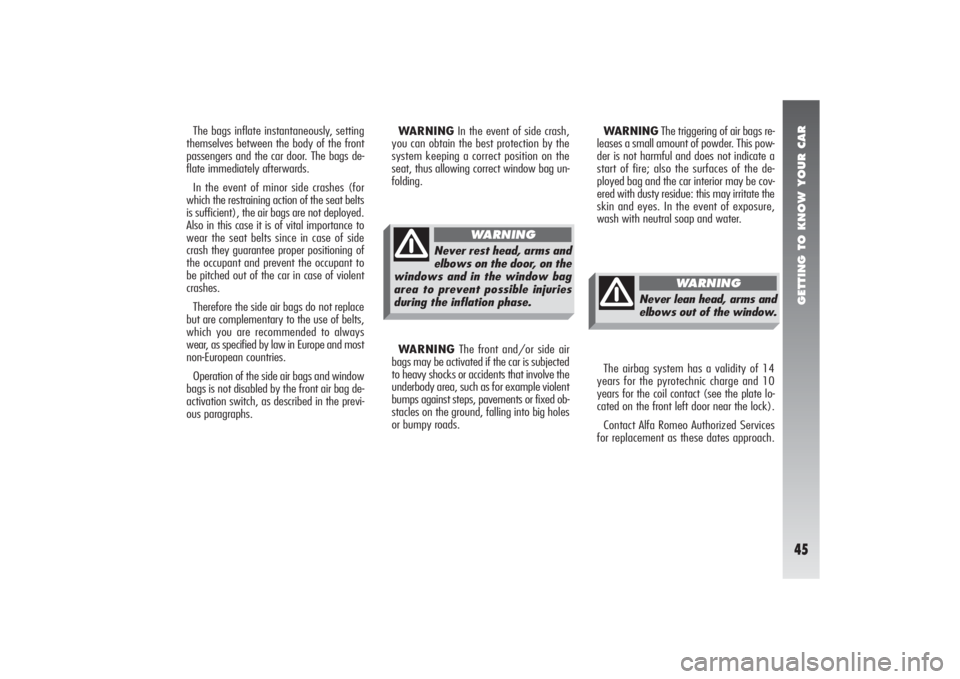
GETTING TO KNOW YOUR CAR45
The bags inflate instantaneously, setting
themselves between the body of the front
passengers and the car door. The bags de-
flate immediately afterwards.
In the event of minor side crashes (for
which the restraining action of the seat belts
is sufficient), the air bags are not deployed.
Also in this case it is of vital importance to
wear the seat belts since in case of side
crash they guarantee proper positioning of
the occupant and prevent the occupant to
be pitched out of the car in case of violent
crashes.
Therefore the side air bags do not replace
but are complementary to the use of belts,
which you are recommended to always
wear, as specified by law in Europe and most
non-European countries.
Operation of the side air bags and window
bags is not disabled by the front air bag de-
activation switch, as described in the previ-
ous paragraphs.WARNINGThe front and/or side air
bags may be activated if the car is subjected
to heavy shocks or accidents that involve the
underbody area, such as for example violent
bumps against steps, pavements or fixed ob-
stacles on the ground, falling into big holes
or bumpy roads.WARNINGThe triggering of air bags re-
leases a small amount of powder. This pow-
der is not harmful and does not indicate a
start of fire; also the surfaces of the de-
ployed bag and the car interior may be cov-
ered with dusty residue: this may irritate the
skin and eyes. In the event of exposure,
wash with neutral soap and water. WARNINGIn the event of side crash,
you can obtain the best protection by the
system keeping a correct position on the
seat, thus allowing correct window bag un-
folding.
The airbag system has a validity of 14
years for the pyrotechnic charge and 10
years for the coil contact (see the plate lo-
cated on the front left door near the lock).
Contact Alfa Romeo Authorized Services
for replacement as these dates approach.
Never rest head, arms and
elbows on the door, on the
windows and in the window bag
area to prevent possible injuries
during the inflation phase.
WARNING
Never lean head, arms and
elbows out of the window.
WARNING
Page 48 of 357
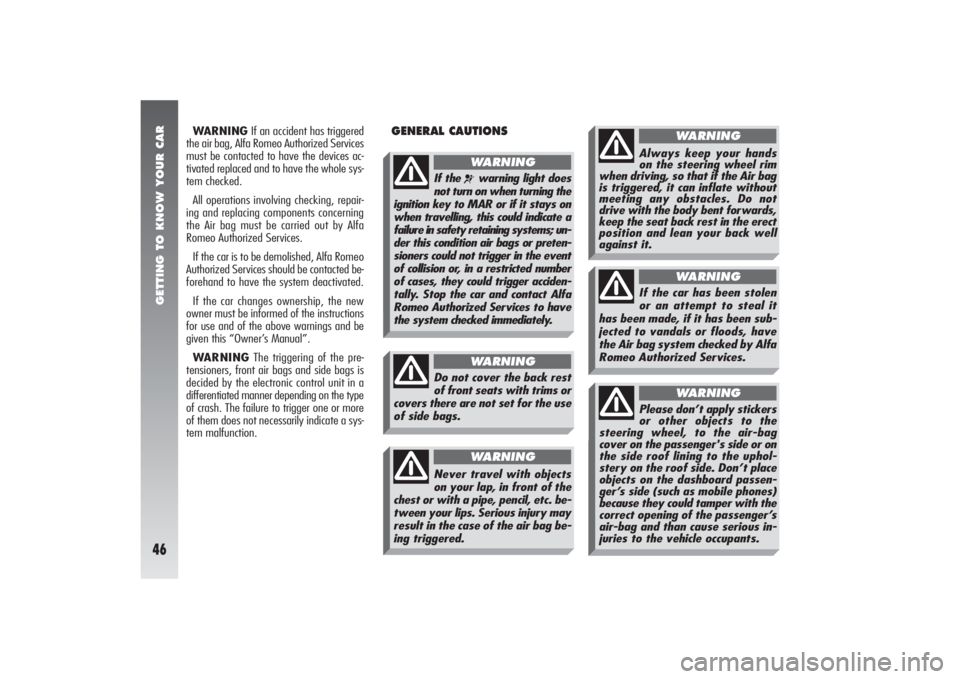
GETTING TO KNOW YOUR CAR46
WARNINGIf an accident has triggered
the air bag, Alfa Romeo Authorized Services
must be contacted to have the devices ac-
tivated replaced and to have the whole sys-
tem checked.
All operations involving checking, repair-
ing and replacing components concerning
the Air bag must be carried out by Alfa
Romeo Authorized Services.
If the car is to be demolished, Alfa Romeo
Authorized Services should be contacted be-
forehand to have the system deactivated.
If the car changes ownership, the new
owner must be informed of the instructions
for use and of the above warnings and be
given this “Owner’s Manual”.
WARNINGThe triggering of the pre-
tensioners, front air bags and side bags is
decided by the electronic control unit in a
differentiated manner depending on the type
of crash. The failure to trigger one or more
of them does not necessarily indicate a sys-
tem malfunction.
GENERAL CAUTIONS
If the
¬
warning light does
not turn on when turning the
ignition key to MAR or if it stays on
when travelling, this could indicate a
failure in safety retaining systems; un-
der this condition air bags or preten-
sioners could not trigger in the event
of collision or, in a restricted number
of cases, they could trigger acciden-
tally. Stop the car and contact Alfa
Romeo Authorized Services to have
the system checked immediately.WARNING
Do not cover the back rest
of front seats with trims or
covers there are not set for the use
of side bags.
WARNING
Never travel with objects
on your lap, in front of the
chest or with a pipe, pencil, etc. be-
tween your lips. Serious injury may
result in the case of the air bag be-
ing triggered.
WARNING
Always keep your hands
on the steering wheel rim
when driving, so that if the Air bag
is triggered, it can inflate without
meeting any obstacles. Do not
drive with the body bent forwards,
keep the seat back rest in the erect
position and lean your back well
against it.
WARNING
If the car has been stolen
or an attempt to steal it
has been made, if it has been sub-
jected to vandals or floods, have
the Air bag system checked by Alfa
Romeo Authorized Services.
WARNING
Please don’t apply stickers
or other objects to the
steering wheel, to the air-bag
cover on the passenger's side or on
the side roof lining to the uphol-
stery on the roof side. Don’t place
objects on the dashboard passen-
ger’s side (such as mobile phones)
because they could tamper with the
correct opening of the passenger’s
air-bag and than cause serious in-
juries to the vehicle occupants.
WARNING
Page 49 of 357

GETTING TO KNOW YOUR CAR47
You are reminded that
when the ignition key is
engaged and in the MAR position,
the Air bags can be triggered also
on a stationary vehicle, if it is
bumped by another moving vehi-
cle. Therefore, even with the car
stationary, never allow children on
the front seat. You are also re-
minded that with the car station-
ary, without the key engaged and
turned, the Air bags are not trig-
gered in the event of an impact; in
this case the failure to trigger the
air bags should not be considered
a system failure.
WARNING
Turning the ignition key to
MAR the
F
warning light
(with the passenger’s front Air bag
deactivation switch at ON) turns
on for about 4 seconds, and then
flashes for another 4 seconds to
remind that the passenger’s Air
bag and corresponding side Air
bags will be activated in the event
of a crash, then it goes off.
WARNING
Do not wash the seat back
with pressurised water or
steam (by hand or at automatic
seat washing stations).
WARNING
The front Air bags are de-
signed to be triggered for
heavier crashes than the preten-
sioners. It is therefore normal for
the pretensioners only to be trig-
gered for crashes within the two
activation thresholds.
WARNING
Do not hook rigid objects to
the coat hooks and to the
support handles.
WARNING
The air bag does not re-
place the seat belts, but in-
creases their effectiveness. Addi-
tionally, as the front air bags are
not triggered for head-on collision
at low speed, side crashes, crashes
from behind or overturning, in
these cases the occupants are pro-
tected only by the seat belts, which
must, therefore, always be fas-
tened.
WARNING
Page 50 of 357
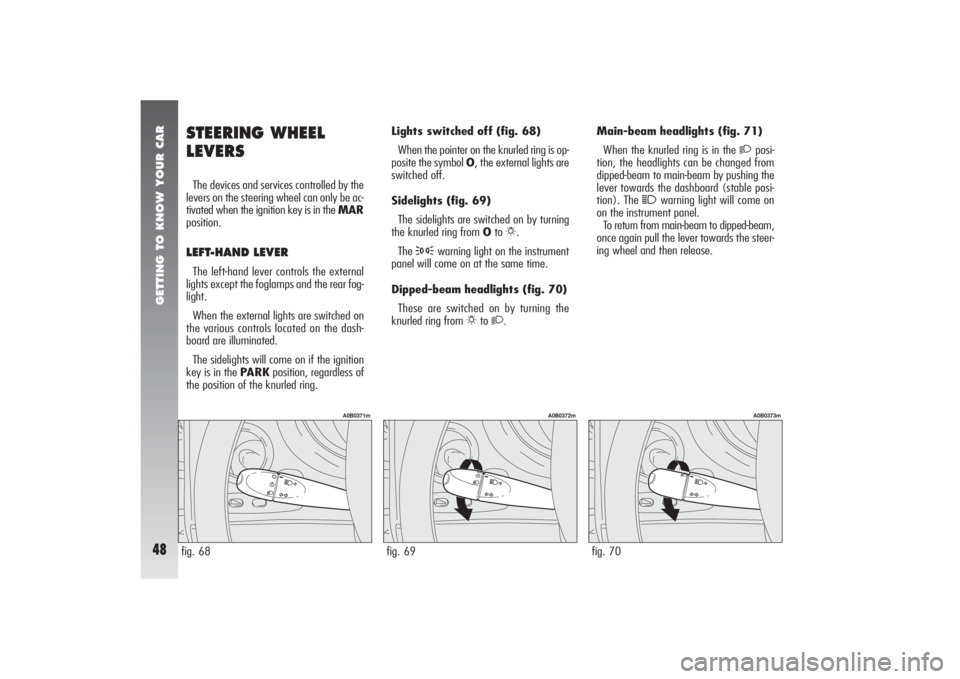
GETTING TO KNOW YOUR CAR48
fig. 70
A0B0373m
STEERING WHEEL
LEVERSThe devices and services controlled by the
levers on the steering wheel can only be ac-
tivated when the ignition key is in the MAR
position.LEFT-HAND LEVERThe left-hand lever controls the external
lights except the foglamps and the rear fog-
light.
When the external lights are switched on
the various controls located on the dash-
board are illuminated.
The sidelights will come on if the ignition
key is in the PARKposition, regardless of
the position of the knurled ring.Lights switched off (fig. 68)
When the pointer on the knurled ring is op-
posite the symbol O, the external lights are
switched off.
Sidelights (fig. 69)
The sidelights are switched on by turning
the knurled ring from Oto
6.
The
3
warning light on the instrument
panel will come on at the same time.
Dipped-beam headlights (fig. 70)
These are switched on by turning the
knurled ring from
6
to 2
.Main-beam headlights (fig. 71)
When the knurled ring is in the
2
posi-
tion, the headlights can be changed from
dipped-beam to main-beam by pushing the
lever towards the dashboard (stable posi-
tion). The
1
warning light will come on
on the instrument panel.
To return from main-beam to dipped-beam,
once again pull the lever towards the steer-
ing wheel and then release.
fig. 68
A0B0371m
fig. 69
A0B0372m